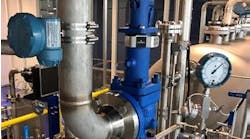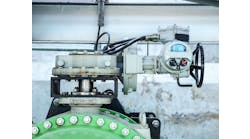H. Crowney
[email protected]
A: Yes, I did use the "Puli" algorithm to optimize several combustion processes, keeping a number of controlled variables (CO, HC, excess O2, temperature, opacity) within safe limits inside a "control envelope." I also used it in a computer chip manufacturing application, and once in a building optimization one.
My best known application was the optimization of the IBM headquarters building at 590 Madison Avenue in New York City, where I optimized the energy consumption by "herding" the heat generated in the interior offices (offices without windows that require cooling even in the winter) to the perimeter offices that have windows, and, therefore, require heating in the winter.
Bela Liptak
[email protected]
Q: I have two questions. We have an existing liquefied petroleum gas (LPG) spherical tank. On it, there is an external-cage, low-level switch. Some modifications are going on, and we have to install an additional level transmitter in parallel with the existing level switch.
I'm asking about the suitability of using a differential pressure cell pressure transmitter and what precautions should be considered to get accurate readings? Shall we use a diaphragm seal or impulse lines filled with a special liquid?
What other choice can we use instead of using a differential pressure cell pressure transmitter?
My second question is this: We have existing LPG spherical tanks. We are going to implement some modifications to the inlet/outlet pipeline on these LPG tanks. One shutdown valve will be installed in the inlet line and one in the outlet line. The client asked us to use (if applicable) shutdown valves with self-detecting pressure drop to close this valve in case of line rupture.
According to my experience, we have to install differential pressure transmitters across the shutdown valve to detect the pressure drop in case of line rupture, but the use of differential pressure measurement requires too much straight line upstream and downstream of the shutdown valves, and in this old plant we do not have it. The client asked us to make survey in the market to find a suitable solution for this problem.
I'm asking about a shutdown valve with the capability to self-detect the pressure drop/loss inside the fluid line (LPG). Is there a pneumatically actuated shutdown valve with self-detecting pressure drop? If yes, what is the vendor name and contacts? Is it proved in the LPG application? What are some of the other suitable solutions for this requirement?
l Ragab Abdel Fattah
[email protected]
Fattah
A: To answer your first question, from the point of view of reliability and availability, my preference is to use a radar gauge. However this would require a large nozzle on the top of the tank and would cost more.
If you decide to use a differential pressure transmitter, you have the following options:
- Fill the low pressure connection with a glycol to seal it.
- Use chemical seals with capillary connections to the differential pressure cell.
- Check with Emerson on the applicability of their remote sensor (3051S ERS). I have not tried it so far.
However it might overcome some of the issues with above options.
In the matter of your second question, since you are installing a differential pressure transmitter for determining the pressure difference, but are not measuring flow, there is no requirement for a straight pipe run. The only thing you should do is study where to install the low-pressure tapping and what setting to select to alarm a leak. Your hydraulic guy can advise this.
Harvindar Gambhir
[email protected]
A: I suggest using a magnetostrictive level sensor, such as manufactured by MTS. It would have a float that floats on the liquid phase of the LPG. The float incorporates a set of magnets, and the sensor detects the position of the magnets within about 0.0005 inch. [Note from Béla Lipták: the position of the magnets might be detected accurately, although not that accurately, but the relationship between the magnets position and the level is much less accurate, because that is also a function of the vapor and liquid densities, which vary with temperature and pressure.]
Dave Nyce
[email protected]
A: Differential pressure measurement is proportional to level, if the densities of both the liquid phases are considered: (density liquid – density vapor). Otherwise, any condensation in the nominally "dry" leg will give a zero error.
Whether LPG "heavies" can condense depends on the ambient temperature swing. A glycol filled "dry" leg is a good solution. I am less enamored of using capillary systems, which can be sensitive to sunlight exposure (try to keep them on the shady side of the tank). Rosemount's system of a HART-coupled LP sensor may be worth exploring.
The magnetostrictive float transmitters can be a good solution, but can be more difficult to install. Note that these have zero error if (liquid density – vapor density) varies significantly, to the point where the float just sinks. The zero error can be as much as 60% of the float length.
Guided-wave radar will work on LPG if selected properly and it's economical, but it really works best inside the vessel, rather than in an external chamber where the LPG may boil due to solar exposure. Thermal insulation can be desirable on external chamber devices of any sort if solar radiation is significant.
Ian H.Gibson
[email protected]
A: In answer to your second question, do this by operating a pneumatic control valve on the basis of pressure drop across it; a lower-maintenance and less expensive solution is to use check valves.
The EFCV consists of a plug, a seat and a spring, all housed or supported in a cylindrical tube. The valve connections can be screwed or flanged as shown in Figure 1.
Under normal operating conditions, the force generated by the flowing process fluid is directed against the valve head and attempts to close it, but the spring is stronger and keeps the valve open. If the flow suddenly increases to an excessive rate, the force against the plug and the differential pressure across it overcomes the spring force, and the valve closes. The EFCV does not require up- and downstream straight runs as the velocity profile across it does not matter.
Inside the EFCV, there are one or more bleed ports around the plug, so that after the valve closed, the bleed can equalize the pressures up- and downstream of the plug, so that it can reopen, if the pressures equalize. However, if a pipe break occurs, the differential pressure across the valve will remain constant (the difference between the pressure on the tank and the atmosphere downstream), and the valve will stay closed until the pipe is repaired. It should be remembered that because of the required seepage through these valves (which provides their equalizing feature) they will not give tight shutoff.
Béla Lipták
[email protected]
A: You can contact Festo Pneumatics, which can provide the following mechanism/pneumatic hook up: a 3/2 N/O (read 3-way, 2-position, normally open) valve, pneumatic operated by loss of pressure, spring-returned, normal position. The required air supply is 6 bar to above the 3/2 N/O valve, while its outlet port above the 3/2 N/O valve connects to your automatic pneumatic shut-off valve. The port that triggers this valve connects to your rupture line for sensing loss of pneumatic pressure.
To increase safety, you can provide redundancy for logic validation on line rupture.
I found such systems on the Internet, by using the key words: "Shutdown Valves, LPG." Your problem is interesting. I am not sure if any of these valves have gotten TÜV approval for emergency shutdown based on the SIL of your plant.
Gerald Liu
[email protected]
A: Do not worry about the straight line segment. That is a requirement for precision flow measurement, but not for your safety systems application. In fact, you cannot use the d/P information for accurate flow measurement since your valve is not an orifice with known diameter. So just install a conventional low-accuracy (if that is less expensive) D/P transmitter across the shutdown valves. The reading at normal times will be zero flow, and some positive reading in case of valve failure to completely shut off. However, I do not understand how a D/P across the valve can detect line rupture without some type of piping diagram.
Richard H. Caro
[email protected]






